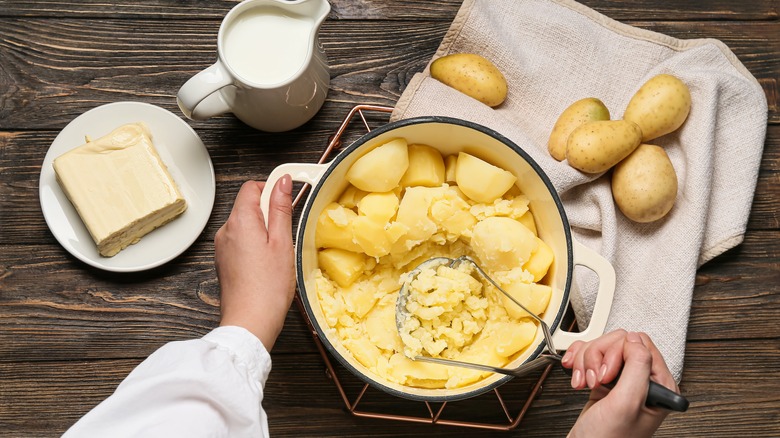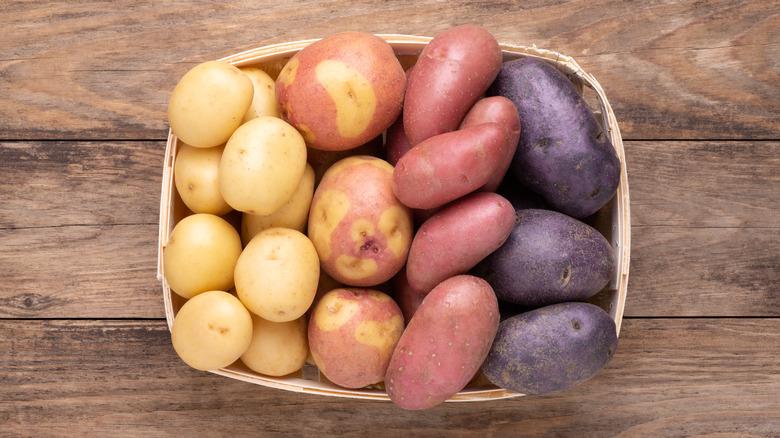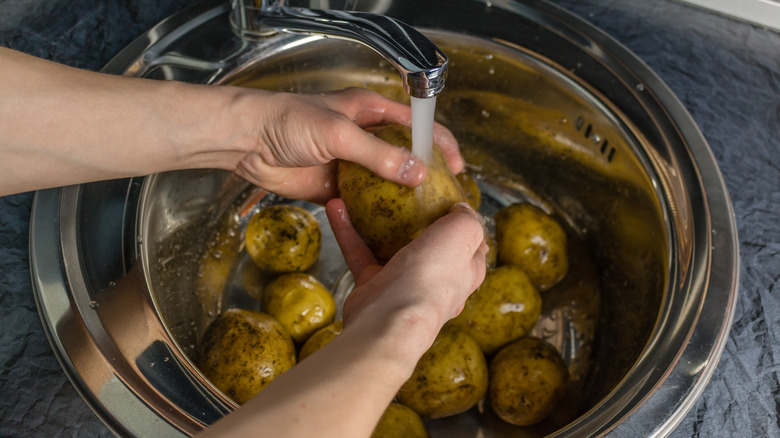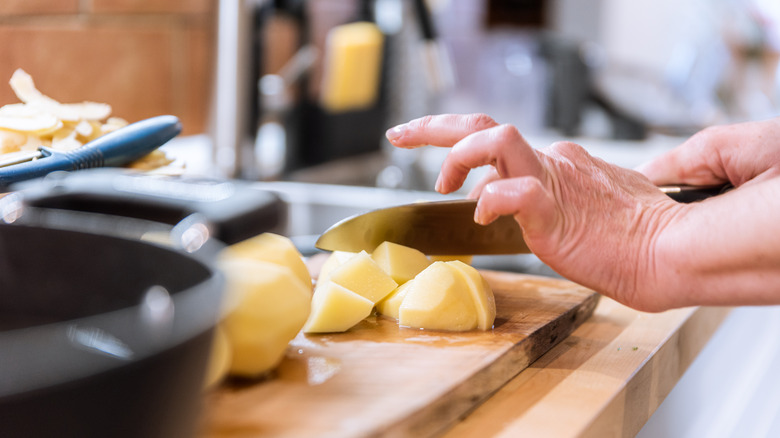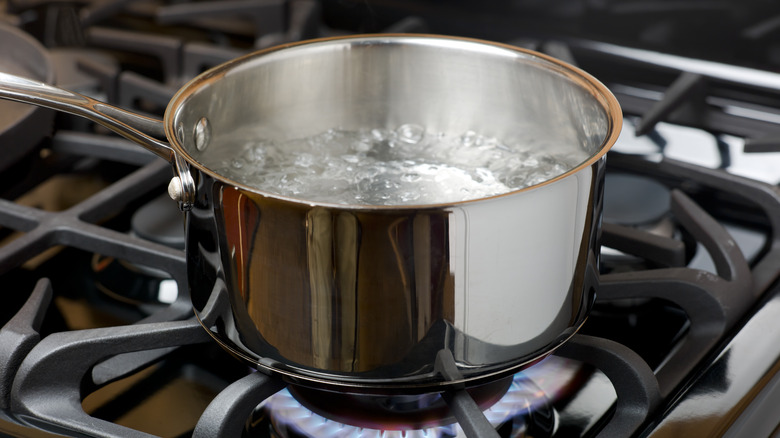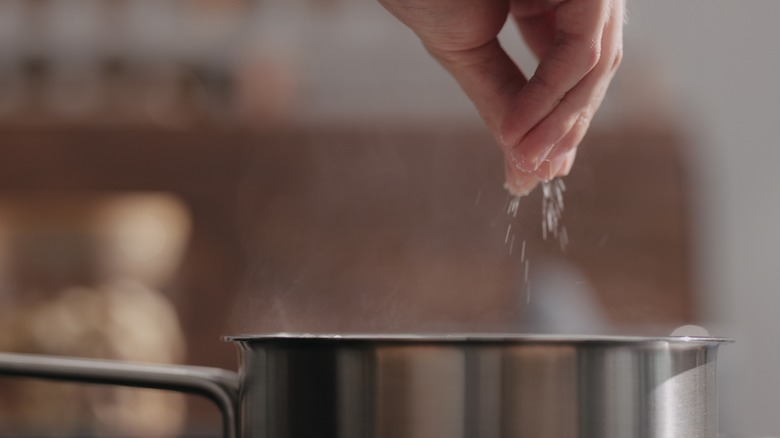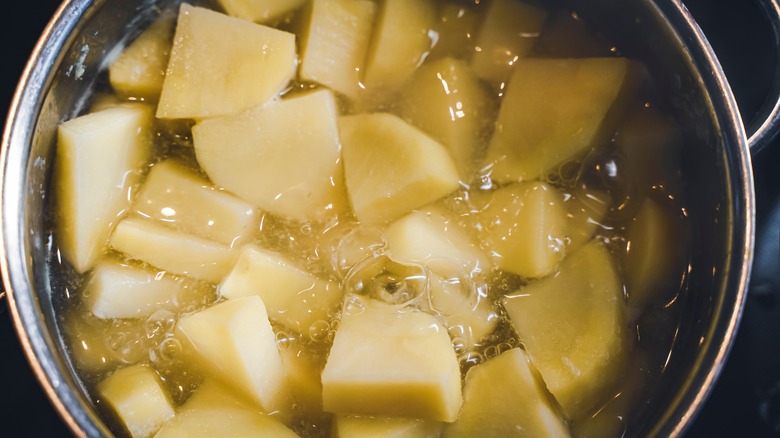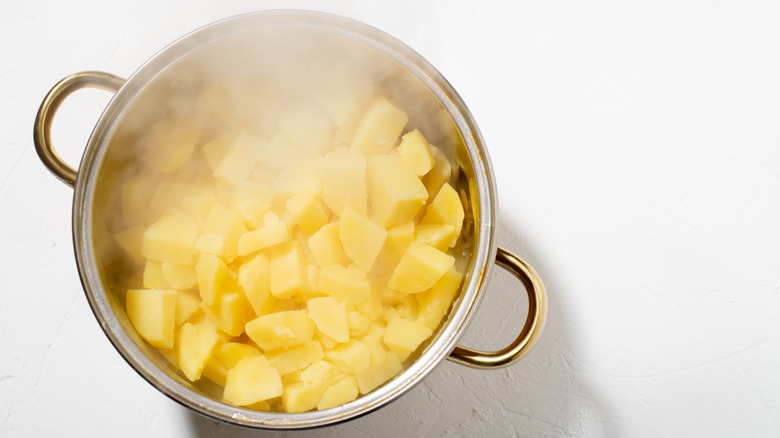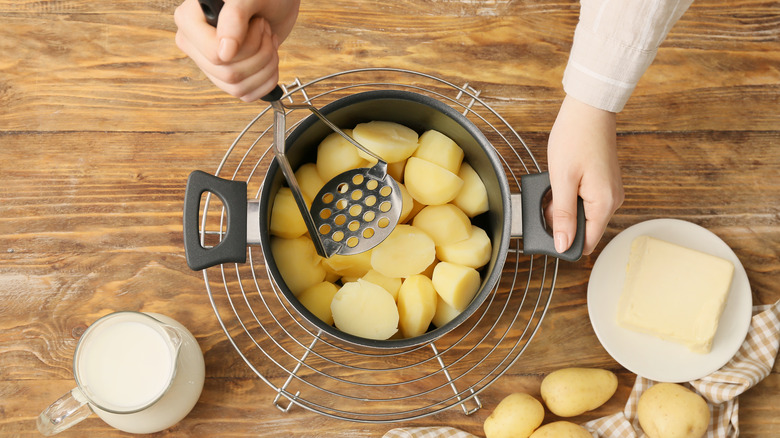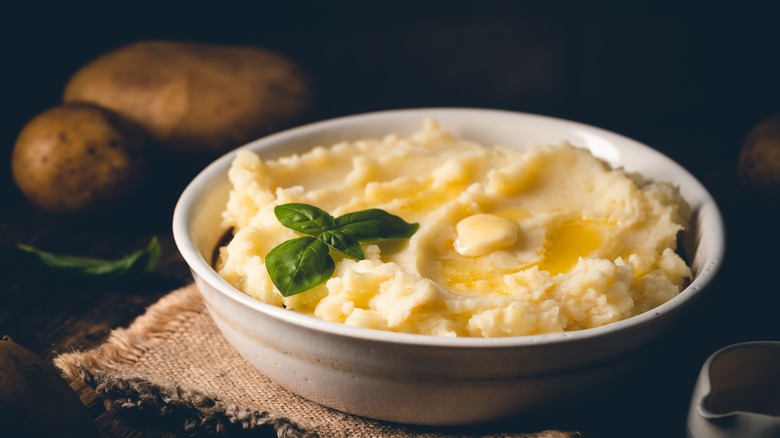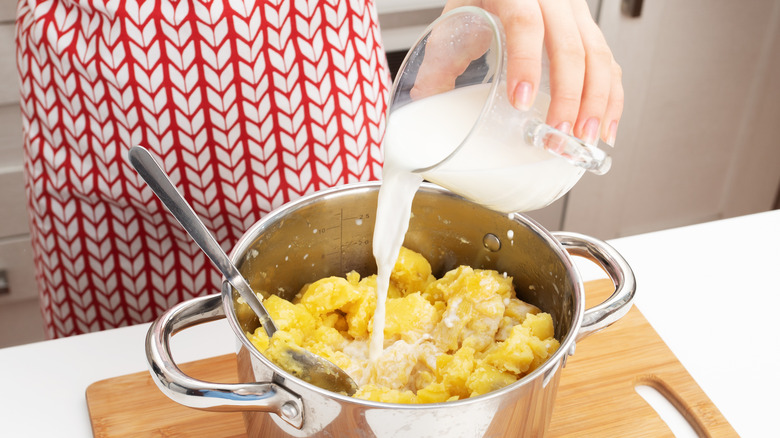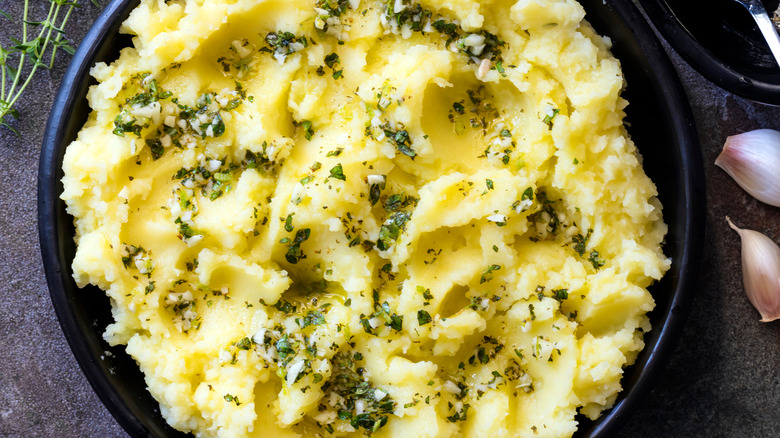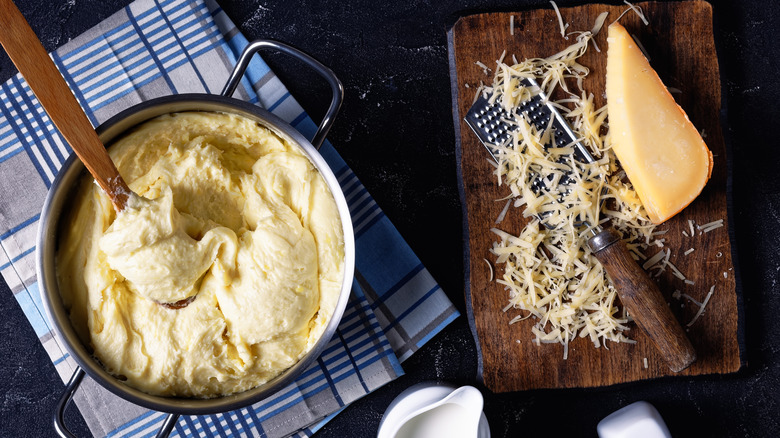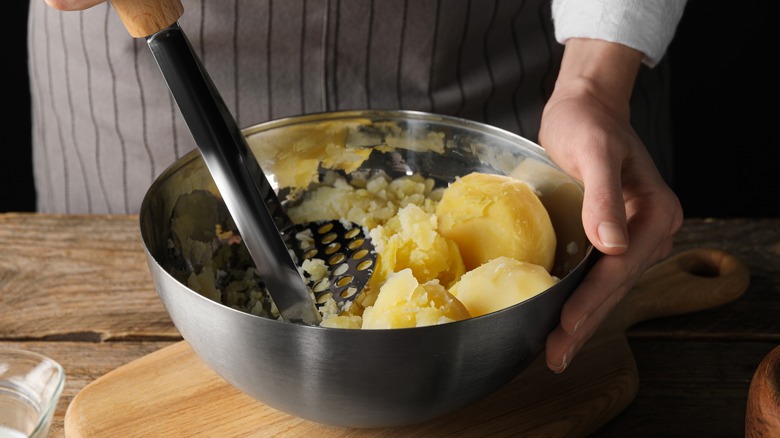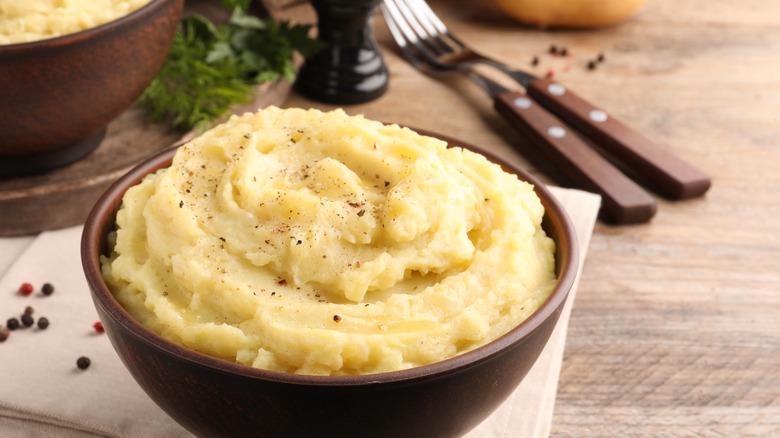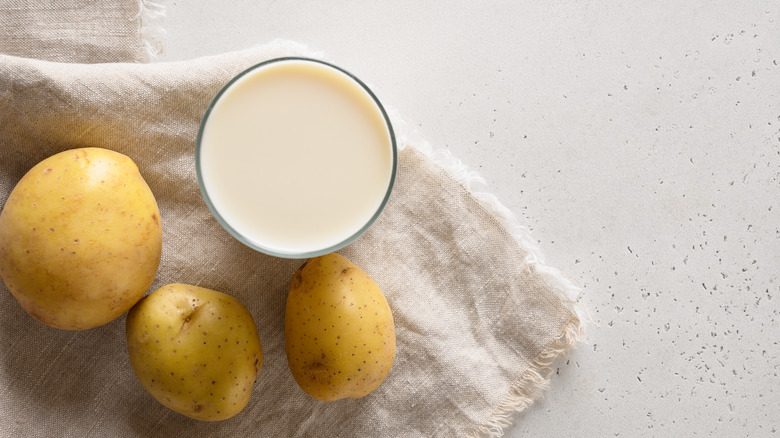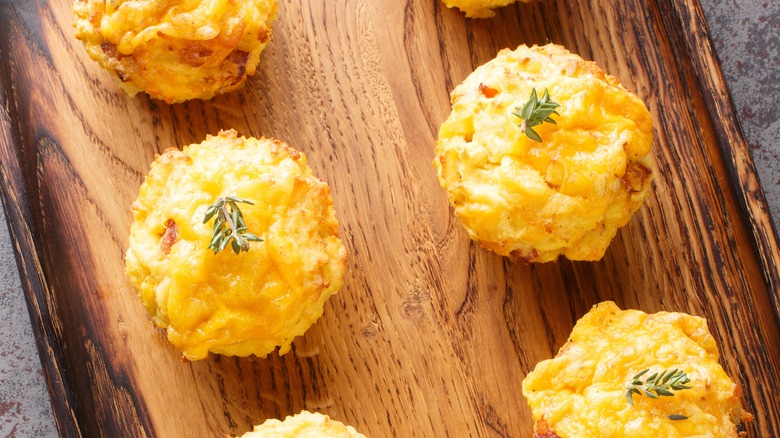16 Common Mistakes To Avoid When Making Mashed Potatoes
Making mashed potatoes sounds easy enough. All you have to do is boil the potatoes, mash them with milk and butter, and stir in a bit of salt. Still, there are plenty of common mistakes that lead to less-than-perfect mashed potatoes. If you've ever made a batch and found they were gluey, watery, dry, or bland, you know what we mean. Fortunately, if you pay attention to the details and know which errors to avoid, you can ensure your mashed potatoes are beyond delicious every time.
To come up with a list of mashed potato missteps and the best ways to avoid them, we considered all the times we've messed them up in the past and what led to their downfall. We also researched countless recipes and considered chef recommendations to better understand how people can fall flat on this seemingly simple (yet surprisingly challenging) dish. Below, we'll uncover 16 common mistakes that you should avoid when making mashed potatoes.
Using the wrong potatoes
There are lots of different kinds of potatoes, and when it comes to mashing them, some fare much better than others. For the most part, potatoes fall into three categories: all-purpose, starchy, and waxy. The best potatoes for mashing tend to be starchy or all-purpose. If you prefer fluffy mashed potatoes with peaks, starchy potatoes like Russet and Idaho are your best bet. They have the ideal texture for mashing and do an excellent job of soaking up milk and butter. All-purpose options like Yukon Gold or Désirée should be your go-to choices if you prefer a heavier mash with richer consistency.
Regardless of which type of mashed potatoes you like best, waxy potatoes should be avoided. Not only do they take more time and effort to peel due to their smaller size, but they also don't absorb other ingredients as well. As a result, your mash won't have the creamy, smooth texture we all strive to achieve. With all this in mind, you should experiment with a few different varieties and an easy mashed potato recipe until you find the perfect potato for your preferences.
Not cleaning your potatoes properly
Once you have the right potatoes picked out, it's time to give them a good scrub. Whether you prefer mashed potatoes with the skins or not, properly cleaning them is a must. After all, they grow underground, so they are covered with dirt and who knows what else. You may wonder if this is truly necessary if you plan on peeling your potatoes, but trust us — it most certainly is. If you don't wash your potatoes before peeling or cutting them, all the residual dirt left on the skins will spread. The dirt flavor may even be absorbed into the actual potato flesh, resulting in a slight soil flavor in your mash. Yuck.
To ensure you wash away all the potential pesticides and dirt on your potatoes, start by running them under water. If you have a produce brush, give them a good scrub. If not, vigorously rub your hands on the skins while holding them under the running water. Then, wipe them off with a paper towel. For good measure, you may want to give them a final rinse after peeling to remove any lingering debris that could have been spread around by the peeler.
Dicing potatoes inconsistently
Once your potatoes are cleaned and peeled, it's time to chop them up into chunks so they can be boiled. This may seem like no big deal, but the size — and shape — of the pieces you make can seriously affect how well your mashed potatoes turn out. If you cut the pieces too thin or small, they soak up lots of water while boiling. If they become saturated in the water, they won't soak up milk and butter as well. Additionally, if your potato pieces are too thin or too small, they may break up in the boiling water, leaving a lot of unusable potato debris in the pot. Conversely, if you cut your potatoes into cubes that are too large, they won't cook all the way through unless you leave them in the water for an extensive amount of time.
Typically, 1½ to 2-inch cubes are best for mashed potatoes. It doesn't have to be exact, but you should aim to make uniform cuts so they all cook evenly. If your potato pieces vary in size too much, you'll wind up with an inconsistent texture when you mash them. With all this in mind, you should also avoid cutting thin slices. Cube-shaped chunks are best. They have the perfect shape to become fork-tender without breaking up or becoming waterlogged.
Boiling the water before adding the potatoes
When boiling most foods, you start by heating up the water. Then, you add whatever it is you want to cook. However, for mashed potatoes, this is not the case. Instead, you want to put the potatoes in the cold water before you put the pot on the stove. This helps ensure each piece cooks consistently all the way through, leading to smooth, creamy mashed potatoes in the end.
Instead of waiting for the water to boil, put your cut-up potatoes in a pot and then fill it with cold water until the water level reaches about an inch or so above the potatoes. Then, put the pot on the stove and bring the water to a boil. It may sound simple, but simply changing the order of operations can make a huge difference in texture and quality.
Why exactly is this a mistake that you want to avoid? First of all, dumping large chunks of potato into water that's already boiling is messy, and the scalding water will splatter. Second, when you add potatoes to water that is already hot, the exteriors start to cook right away. While this doesn't sound too bad, unfortunately, the centers of the potato pieces won't have time to catch up before the outside becomes too tender for a consistent batch of mashed potatoes.
Forgetting to salt the water
Salting the water is another essential step to making mashed potatoes that often gets overlooked. Some people may think that chefs only add salt to the water because an old wive's tale says salt makes water boil faster. Whether you believe it or not, there is actually a much better reason to salt your water: It adds tons of flavor to whatever you're cooking. With foods like pasta, adding salt to the cooking water is the only way to allow flavor to seep into the actual pasta. With mashed potatoes, this isn't as crucial because you'll have plenty of time to add seasonings later; but it still gives you a significant head start.
Don't hold back when salting your boiling water. You want to make sure you add enough that it actually seasons your potatoes. If you add too little, it won't have much of an effect. Many professional chefs recommend adding enough salt so the water becomes as salty as the sea. So, if you're making a large batch of mashed potatoes, this could be as much as a tablespoon. Another thing chefs frequently recommend is to always add salt after the water is boiling. That way, it won't stick to the bottom of the pan and potentially leave unsightly marks behind.
Over or undercooking the potatoes
Potatoes need to be cooked just right if you want to make smooth, creamy mash out of them. They can't be over or undercooked. If they are, your mashed potatoes will suffer considerably regarding texture and manageability. When undercooked, they will be hard to mash. Even if you manage to mash them, it's unlikely you'll get a smooth texture devoid of hard chunks. On the other hand, overcooking your potatoes results in issues, too. If you leave your potatoes in boiling water for too long, they become waterlogged. They may mash effortlessly, but all the excess liquid makes it hard for them to absorb milk and butter. Plus, the extra water can easily make your mashed potatoes runny and resistant to fluffing up.
Unfortunately, there isn't a specific cooking time when it comes to boiling potatoes for mashing. There's too much potential for variation regarding the type of potato you use and the size of the chunks. Still, you must get the timing right. While this may sound somewhat tricky, don't overthink it. Typically, you'll need to boil your potatoes for about 15 to 20 minutes to get the right level of tenderness. They're ready as soon as a fork or knife easily pierces all the way through with no resistance. If you watch your potatoes closely, you should be able to extract them at the appropriate time without any issues.
Mashing the potatoes before they are properly strained
Once you pull your cooked potatoes out of the boiling water, it's tempting just to toss them in a bowl and start mashing right away. Resist the urge. One of the best things you can do for your mashed potatoes is give the boiled potatoes enough time to properly drain before taking any further steps. If you don't, your mashed potatoes will suffer. Just like overcooking your potatoes, not allowing them to drain leads to excess water in your final dish. The extra water makes it hard to achieve fluffy mashed potatoes. It also dilutes the milk and butter, so your dish won't get as creamy and smooth.
To avoid this common mistake, all you have to do is be patient — not even for that long. A minute or two should be plenty of time. Simply pour your boiling water and potatoes into a colander and then leave the potatoes to sit for a moment before transferring them to a bowl for mashing. Make sure you don't forget them, though; seriously, a minute or two is good. If you leave them much longer than that, your mashed potatoes won't be hot.
Adding cold butter and milk
Milk and butter are essential elements of mashed potatoes. While mixing them into your mash is pretty straightforward, adding them cold is one of the biggest mistakes you can make when creating this delicious dish. Even when made correctly, mashed potatoes are best hot. Once they start to cool down, they become stiff and dry. Unfortunately, this happens pretty quickly, particularly if you mix in cold ingredients. One of the best ways to prevent an overly rapid cooling down of your potatoes is to avoid adding cold milk and butter. If you do, your mashed potatoes barely stand a chance of reaching the table before they drastically drop in temperature.
Luckily, warming milk and butter for mashed potatoes is super easy. All you have to do is toss them in the microwave for 15 to 30 seconds. Don't overheat the milk to boiling; it should be just warm enough that it won't add a chill to the other ingredients. The butter should be hot and melted so it blends in easily and adds warmth to the bowl. At the very least, room temperature milk and butter still results in a significant improvement regarding the temperature of the overall dish.
Not using enough butter
Butter is the main flavor booster in basic mashed potatoes. Sure, you can add other seasonings and whatnot, but butter is what gives mashed potatoes their decadent flavor and velvety texture. So, even if you're trying to be more health-conscious, butter is key. This isn't the time to hold back or experiment with reducing the amount of butter used in your recipe. If you do, you'll likely wind up with bland mashed potatoes.
Professional cooks and chefs use way more butter than you might think. Actually, it's one of the reasons food tastes so much better at a restaurant. Of course, the amount of butter you put in your mashed potatoes will vary based on your personal taste, so feel free to play around. Just remember that when it comes to butter, skimping is not recommended. Celebrity Chef Gordon Ramsay uses about 5 tablespoons of butter for approximately 2 pounds of potatoes. Martha Stewart's recipe suggests 4 tablespoons for every 2 pounds of potatoes. Start with a similar amount, or maybe a touch less, and play around until you get the blend just right.
Adding too much milk
Ideally, mashed potatoes should be perfectly creamy and have a smooth texture that stands in fluffy peaks. Even if you like them a bit chunky, they should still be velvety overall. Aside from butter, milk is the key to achieving the perfect consistency. However, if you add too much milk, mashed potatoes quickly become runny and unappetizing. So pay close attention as you mix, add the milk slowly, and don't go overboard.
Approximately ⅔ cup of milk should be plenty for a pound of potatoes, but this amount may vary based on the type of potatoes you are mashing. It's recommended to start with slightly less milk than your recipe calls for because you can always add more as needed. If you accidentally add too much milk, it can be hard to come back from. All will not be lost if you do — you can bulk up your mashed potatoes with cheese and other ingredients to enhance texture and soak up the excess. Still, adding these things should be for flavor, not to salvage a mistake.
Holding back on the herbs and spices
Everyone knows salt and pepper add flavor to mashed potatoes. In fact, many people shake some more of each onto their serving when it reaches their plate. So, it may seem obvious, but you definitely want to mix a bit of each into your recipe. What may not be so apparent to some home cooks is that you don't have to stop with these basic seasonings. Mashed potatoes are extremely versatile, and they pair wonderfully with a world of herbs and spices. From rosemary to thyme to dill, and from garlic to chili flakes, the sky's the limit.
If you're trying to determine what you want to add to your mashed potatoes, consider what you are serving them with and add complementary flavors. For example, if you're making a roast with brown gravy, savory additions like garlic, onion powder, and thyme make fantastic choices. If you're serving mashed potatoes with roasted veggies and spicy chicken, dill or garlic pairs wonderfully. Another popular addition is crushed rosemary: It has a subtle yet noticeable flavor that complements almost any dish. To help coax more flavor out of dried rosemary, crush it in the palm of your hand before sprinkling it in. You could use a mortar and pestle, but your hands are much quicker.
Leaving out flavorful mix-ins
In addition to herbs and spices, mashed potatoes have endless potential when it comes to integrating other ingredients to enhance flavor. Simple mashed potatoes are delicious just the way they are, but sometimes you need to spice things up. For many home cooks, this means adding cheese. When you want a touch of smokiness, add Gouda. Provolone and Havarti are other top picks, but really, you can add any kind of cheese you like. In addition to cheese, try adding a swirl of truffle oil to the entire batch or right on top of each serving. Either way, the flavor will be unbelievably decadent.
Diced green onions or chives are pretty popular mashed potato toppings as well. Like truffle oil, they can be mixed in or sprinkled on top to give your mashed potatoes a pop of color and a burst of fresh flavor. Bacon is another fantastic addition. It adds a smoky, fatty element and some extra salt. When cooked until crispy, it also adds a contrasting crunch that many people enjoy.
For a more creative, unexpected enhancement, try adding cream of mushroom soup to your mashed potatoes. The creamy texture and earthy flavor will blow your mind. Or, try making French onion dip mashed potatoes for a unique rendition that blows everything else out of the water.
Overmashing or blending the potatoes
To make mashed potatoes, you obviously have to mash your boiled potatoes. To achieve a super smooth texture, you have to work them quite a bit, but this is where the potential for error occurs. As it turns out, potatoes don't hold up well when overworked. Even with the right amount of milk and butter, they easily become gluey when over-mashed, and this is a complete deal-breaker. To prevent this from happening, stop mashing the moment you get the texture right. The fine line between creamy and gluey is, unfortunately, quite close.
Often, choosing the right tool for mashed potatoes is key if you want to avoid overworking them — which you do. If you enjoy chunkier mash, a hand masher is best. It does a great job of breaking up the potatoes, leaves chunks behind, and makes it difficult to over-mash. A hand mixer also works, but you'll have to make sure not to go past the point of no return. If ultra-smooth mashed potatoes are more your style, a ricer or food mill is your best bet. These tools make it incredibly simple to break down the potatoes into minuscule bits without manipulating them very much, so they're basically foolproof. Whatever you do, stay away from food processors or blenders. The rapid speeds of these appliances often result in the dreaded gluey texture.
Not serving them immediately
One of the biggest disservices you can do to a fresh batch of mashed potatoes is not serve it immediately. Once ready, mashed potatoes lose their heat rapidly — and as we all know, they taste the best when they're hot. The last thing you want is for all your hard work to go to waste, so do yourself a favor and time this dish so you can serve it the moment it's done. When served immediately, they'll still be hot and perfectly creamy, just the way we all like them.
Reheating mashed potatoes isn't impossible, but no one wants to reheat a dish before it's been served and enjoyed. Things happen, though, and you have a couple of options when they do. First, you can cover the mashed potatoes to help them retain heat, but this won't help for long. Second, you can put them in the oven at a low temperature to keep them warm. However, anything longer than a couple of minutes may cause them to dry out. You can always add more milk, but readjusting your proportions and ingredients isn't ideal, and this increases the risk of over-mashing them. So, try to serve them as quickly as possible.
Choosing a low-fat milk
With all the different kinds of milk on the market today, it can be hard to keep track of all your options. However, mashed potatoes are best with plain old full-fat whole milk. Many people gravitate towards low-fat milk for health reasons, but using it in your mashed potatoes is a mistake. If you disregard this warning and use low-fat milk, achieving the decadent, rich flavor you expect from drool-worthy mashed potatoes will be nearly impossible. This may sound excessive to some, but you can even use heavy whipping cream for the creamiest, most velvety mash ever.
If you or someone you're cooking for is lactose intolerant or vegan, you'll have to substitute cow's milk for an alternative milk. While they won't be quite the same, you still have some excellent options that will get you pretty close. The key is picking a plant-based milk that is high in fat. You'll find the highest fat content in coconut, Brazil nut, walnut, soy, and pistachio milk. Keep the flavor profile in mind: Pistachio or walnut milk can add a nutty flavor to mashed potatoes, while coconut milk can make the dish too sweet. Of course, you'll also have to substitute butter if you're cooking for a vegan, but that's to be expected.
Allowing the leftovers to go to waste
The final mistake you should avoid is letting your tasty mashed potato leftovers go to waste. Sure, you can reheat mashed potatoes, but they're never quite the same after they cool down. They dry out and lose their creamy consistency. Still, that doesn't mean you need to throw them away. The trick to reheating mashed potatoes lies in adding a touch more milk and butter. Typically, this restores them to something close to their original glory.
If you already got your fill of plain mashed potatoes during your initial meal, there are plenty of delicious ways to repurpose leftovers. You can easily transform them into a myriad of other dishes to change their flavor and make them something entirely different. Plus, starting with pre-made mashed potatoes often makes recipes much easier to execute, so it's a win-win.
One popular way to utilize leftover mashed potatoes is to turn them into a filling for homemade pierogies. If that sounds a bit involved, consider using them as the topping for shepherd's pie instead. Crispy mashed potato croquettes are another favorite. They make an outstanding appetizer and pair particularly well with a ranch dip. Using leftover mashed potatoes for the base of gnocchi, muffins, or classic latkes are all phenomenal ways to repurpose them. Whatever you decide, just don't toss them out. After all, you put so much effort into making them, so why miss out on another opportunity to enjoy them?

